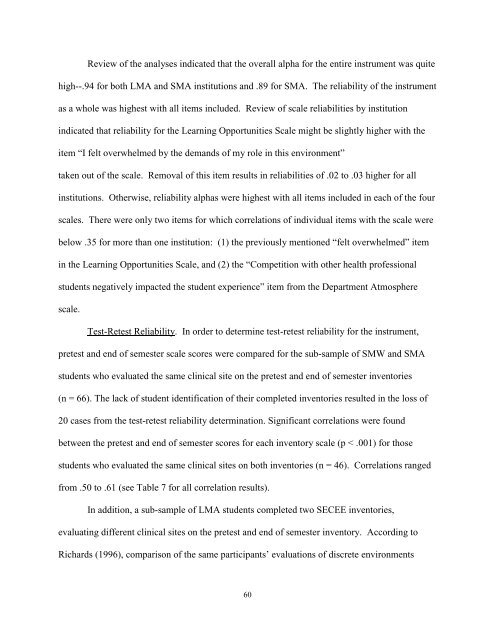STUDENT EVALUATION OF CLINICAL EDUCATION ENVIRONMENT
STUDENT EVALUATION OF CLINICAL EDUCATION ENVIRONMENT
STUDENT EVALUATION OF CLINICAL EDUCATION ENVIRONMENT
You also want an ePaper? Increase the reach of your titles
YUMPU automatically turns print PDFs into web optimized ePapers that Google loves.
Review of the analyses indicated that the overall alpha for the entire instrument was quite<br />
high--.94 for both LMA and SMA institutions and .89 for SMA. The reliability of the instrument<br />
as a whole was highest with all items included. Review of scale reliabilities by institution<br />
indicated that reliability for the Learning Opportunities Scale might be slightly higher with the<br />
item “I felt overwhelmed by the demands of my role in this environment”<br />
taken out of the scale. Removal of this item results in reliabilities of .02 to .03 higher for all<br />
institutions. Otherwise, reliability alphas were highest with all items included in each of the four<br />
scales. There were only two items for which correlations of individual items with the scale were<br />
below .35 for more than one institution: (1) the previously mentioned “felt overwhelmed” item<br />
in the Learning Opportunities Scale, and (2) the “Competition with other health professional<br />
students negatively impacted the student experience” item from the Department Atmosphere<br />
scale.<br />
Test-Retest Reliability. In order to determine test-retest reliability for the instrument,<br />
pretest and end of semester scale scores were compared for the sub-sample of SMW and SMA<br />
students who evaluated the same clinical site on the pretest and end of semester inventories<br />
(n = 66). The lack of student identification of their completed inventories resulted in the loss of<br />
20 cases from the test-retest reliability determination. Significant correlations were found<br />
between the pretest and end of semester scores for each inventory scale (p < .001) for those<br />
students who evaluated the same clinical sites on both inventories (n = 46). Correlations ranged<br />
from .50 to .61 (see Table 7 for all correlation results).<br />
In addition, a sub-sample of LMA students completed two SECEE inventories,<br />
evaluating different clinical sites on the pretest and end of semester inventory. According to<br />
Richards (1996), comparison of the same participants’ evaluations of discrete environments<br />
60












